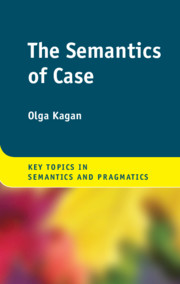Book contents
- The Semantics of Case
- Key Topics in Semantics and Pragmatics
- The Semantics of Case
- Copyright page
- Dedication
- Contents
- Figures
- Tables
- Acknowledgments
- Abbreviations
- 1 Introduction
- 2 Dative Case
- 3 Spatial Cases
- 4 Case and Aspect
- 5 Differential Object Marking
- 6 The Genitive/Accusative Alternation in Balto-Slavic
- 7 Predicate Case
- 8 Generalizations and Conclusions
- Terminology
- Bibliography
- Index
4 - Case and Aspect
Published online by Cambridge University Press: 02 April 2020
- The Semantics of Case
- Key Topics in Semantics and Pragmatics
- The Semantics of Case
- Copyright page
- Dedication
- Contents
- Figures
- Tables
- Acknowledgments
- Abbreviations
- 1 Introduction
- 2 Dative Case
- 3 Spatial Cases
- 4 Case and Aspect
- 5 Differential Object Marking
- 6 The Genitive/Accusative Alternation in Balto-Slavic
- 7 Predicate Case
- 8 Generalizations and Conclusions
- Terminology
- Bibliography
- Index
Summary
Chapter 4 is devoted to the intricate relation between case-marking and aspect. The first section deals with the partitive/accusative alternation on direct objects in Finnic languages. Typically, partitive objects correlate with a bounded reading of the VP, and accusative objects with an unbounded one. But this analysis is challenged by a group of Finnish stative predicates which require accusative complements, such as omistaa ‘own’ and sisältää ‘contain’. The chapter introduces the analyses that have been proposed to account for this fact. Section 4.2 turns to the topic of accusative adjuncts. Cross-linguistically, accusative case tends to be assigned to adjuncts that function as event delimiters, e.g. by measuring out an event along a time or path scale. It is shown that in several languages, event-delimiting adjuncts undergo the same alternations as direct objects, and evidence is provided that they receive structural accusative case. Both syntactic and semantic analyses of accusative objects and adjuncts are discussed. Finally, Section 4.3 considers accusative case-assignment to complements of goal prepositions in German, Russian and Ancient Greek, asking whether this phenomenon is related to the aspectual function of accusative case.
Keywords
Information
- Type
- Chapter
- Information
- The Semantics of Case , pp. 99 - 146Publisher: Cambridge University PressPrint publication year: 2020
